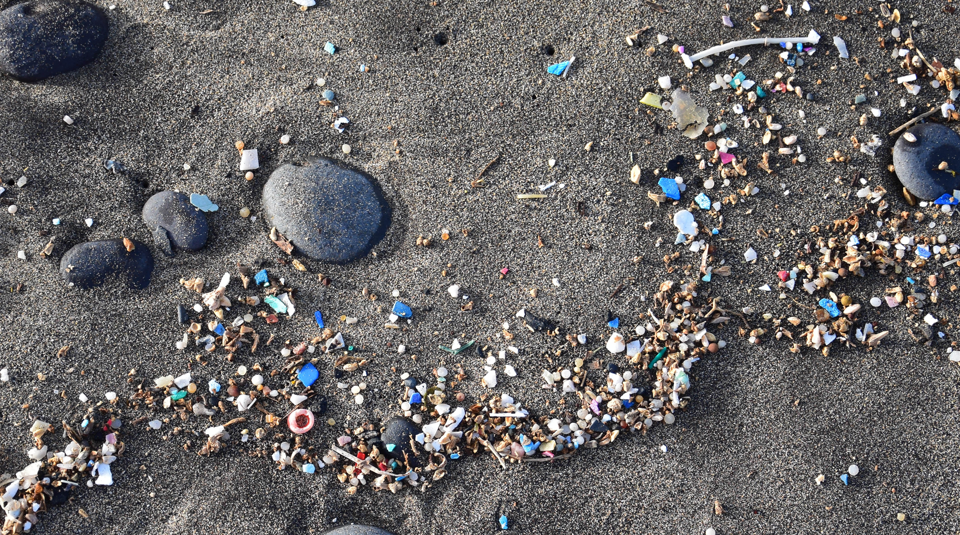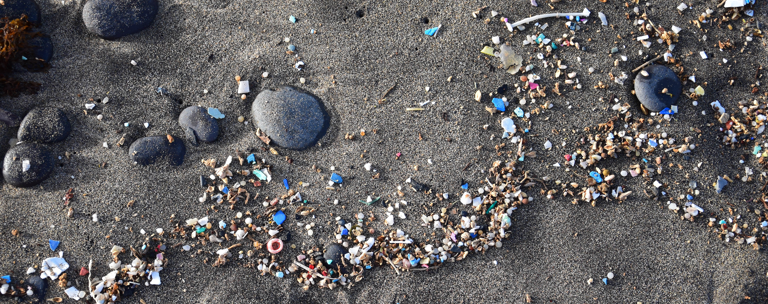Despite their size, microplastics pose a significant threat to our planet and human health. And we’re still working to figure out exactly what that means for us – including here in Aotearoa. ESR Science Leader Dr Olga Pantos shares findings from AIM², a five-year ESR-led microplastics research project.
Microplastics, particles of plastic less than five millimetres in size, are rapidly becoming one of the most pervasive pollutants in our environment. They continue to fragment over time, becoming ‘nanoplastics’ once they’re less than a micrometre in size. These seemingly insignificant particles have infiltrated every corner of the globe, from the deepest ocean trenches to the highest mountain peaks. Despite their minuscule size, microplastics pose a significant threat to ecosystems and human health. And we’re still working to figure out exactly what that all means for us – including here in Aotearoa New Zealand.
The health of the planet affects us all – both now and for generations to come. The full impact the pressures we’re exerting on the environment, and therefore also us, may not be realized for decades. Until relatively recently plastics have been considered inert, with their impacts mostly aesthetic (think untidy beaches) or limited to large marine animals. However, there is growing evidence of direct and indirect consequences of plastics, from the extraction of fossil fuels and their chemical conversion into synthetic polymers, to the plastic’s end-of-life fate.
Although Aotearoa doesn’t produce plastics from raw materials, there is extensive local manufacturing of plastics and use in daily life, from clothing to food production and packaging and transport. The imported products and raw plastics used by manufacturers present a pollution risk throughout their long journey from their point of origin to the customer. Once here, they’re a source of particulate plastic pollution due to general wear and tear, and then once thrown away. Even if disposed of appropriately, they present a potential source of pollution.
The severity and nature of the impacts of plastic pollution depends on several factors, including size, polymer type, associated chemicals (inherent and acquired), age and the organisms and environments they interact with. Small plastic particles (nano- and microplastics) have received considerable attention over recent years; however, very little was known about the quantity and distribution in Aotearoa's environments or the threat they pose its unique flora, fauna, and ecosystems.
This March marked the end of the five-year Ministry of Business, Innovation and Employment (MBIE) Endeavour Research Programme-funded project (C03X1802), Aotearoa Impacts and Mitigation of Microplastics (AIM²). This project brought together a transdisciplinary team of researchers with expertise in polymer and environmental chemistry; molecular, microbial, freshwater and marine, biology; oceanography; ecotoxicology; microscopy, social science and mātauranga Māori from six institutes across the motu, who worked together to address these knowledge gaps.
The project consisted of three main objectives: 1) to improve knowledge of the levels, types, and movement of microplastics across a range of environments; 2) to identify potential impacts on organisms and ecosystems, including from marine pests and pathogens which could cause significant damage to native habitats and the fisheries industry; and 3) identify ways to reduce the levels of impact.
The findings of this project have been published in peer-reviewed scientific journals (more than 40 articles are currently available) and have been presented at numerous domestic and international conferences, webinars, hui and outreach events. This research has helped fill the knowledge gaps in areas ranging from the accumulation and retention of microplastics in urban streams, estuaries and terrestrial soils to the interactions of biota and plastics in freshwater and marine coastal environments.
Some key takeaways include:
- Aotearoa’s coastal areas at first sight appear to be relatively plastic pollution-free. However, by developing new methods to isolate very small particles, we’ve demonstrated even beaches in remote areas contain thousands of microplastic particles per kilogram of sand.
- Aotearoa’s iconic marine fauna, from green-lipped mussels to dolphins are ingesting microplastic pollution, either directly from the surrounding water or through the food chain.
- The chemical additives in plastics leach into water over time, posing a threat to the health of the immediate environment.
- Plastic pollution collected from beaches around the motu contain a cocktail of chemical contaminants which can be absorbed by wildlife if the plastics are ingested.
- Plastic increases the uptake of additive chemicals into freshwater and marine biota and can move through aquatic food chains.
- The communities that form on plastics in the coastal waters of Aotearoa can facilitate the translocation of algae and animals, including pests and pathogens, around the coastline posing a threat to ecosystems and nature-based industries.
- Biowaste and biowaste products act as a route of entry for microplastics into productive soils posing a threat to soil health and function.
- Wastewater treatment plants release hundreds of thousands microplastic particles to the environment in treated effluent. Potential human pathogens are present in the biofilm communities that form on plastics in wastewater, resulting in the plastic particles facilitating their release into the environment.
This research has significantly contributed to the international understanding of the risks posed by plastic pollution and has identified specific threats to Aotearoa’s unique environments. However, the diverse nature of plastics, the wide range of environments and organisms they come in to contact with, and the long timescales over which their impacts can occur (decades to centuries), means there is still much to learn of current and future effects.
With a constantly increasing body of evidence about the wide-ranging impacts of plastic on the environment and human health – including recent evidence of nano- and microplastic particles in cardiac plaques linked to an increased risk of heart attack, stroke, and death, and their presence in testicular tissues being attributed to reduced male fertility – it’s clear the human relationship and reliance on plastics, and the nature of plastic itself, has to change to protect human health and the environment for generations to come.
No matter who and where you are, reducing your use of plastic now will contribute to protecting your health, your families’ health, and the health of the planet from the negative impacts of plastic pollution.


